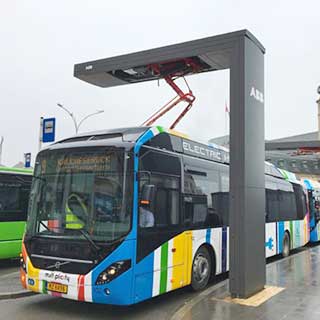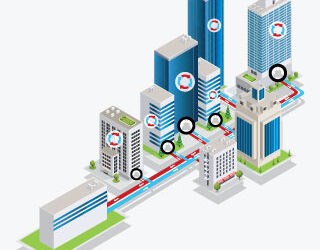Electric Buses: Where and How to Charge Them?

Electrification of public bus fleets is a key priority for many cities around the world to tackle air pollution. To give a push to clean mobility in public transportation, the Government of India (GoI), through the Department of Heavy Industry (DHI), sanctioned 5,595 electric buses to 64 cities/state govt. entities/State Transportation Undertakings (STUs) for intra-city and intercity operations. This leaves almost no scope for errors for it may impact public transportation adversely; proper planning needs to be in place to create the desired infrastructure to support and ensure a seamless transition.
When and where to charge the bus
The origin and destination depots or terminals are potential sites for setting up charging stations for an e-bus fleet. Additionally, an en route charging or an intermediate charging setup may also be required for longer distances.
Buses can be charged overnight when they are not in operation, and during any available free time during operational hours.
How to charge the bus
 There are several ways of charging an electric bus using an Electric Vehicle Service Equipment (EVSE). Buses are commonly charged with the help of wired connections, using AC or DC charging. A bus can be charged by an AC charging technology if it has an on-board charger. Buses, manufactured by Olectra-BYD, plying the Indian roads have two on-board chargers of 40kW capacity each. In the case of DC charging, chargers are located outside the vehicle. A recent study shows that other bus manufacturers in India have chosen DC charging at 70kW for buses. Globally, the most popular way to charge buses is by using the DC plug in charging technology at 50kW or above.
There are several ways of charging an electric bus using an Electric Vehicle Service Equipment (EVSE). Buses are commonly charged with the help of wired connections, using AC or DC charging. A bus can be charged by an AC charging technology if it has an on-board charger. Buses, manufactured by Olectra-BYD, plying the Indian roads have two on-board chargers of 40kW capacity each. In the case of DC charging, chargers are located outside the vehicle. A recent study shows that other bus manufacturers in India have chosen DC charging at 70kW for buses. Globally, the most popular way to charge buses is by using the DC plug in charging technology at 50kW or above.
 DC plug in charging of bus
DC plug in charging of bus
Alliance for an Energy Efficient Economy (AEEE) conducted a comparative assessment of the charging options for buses using a set of critical parameters to identify the most suitable option for charging e-buses in India. The analysis showed that plug in AC and DC charging methods are the most possible charging technologies for charging e-buses in India.
For quick bus charging at intermediate stops, high power DC charging at 150 kW or above is used in the global market. Such high power DC charging needs a special arrangement called pantograph systems instead of wires as shown below.
 DC Pantograph system for quick bus charging
DC Pantograph system for quick bus charging
These DC charging systems are relatively expensive than the low power DC charging systems but can serve more vehicles in a short span of time.
The 600kW flash charging stations used for buses in Geneva provide a quick power boost in a span of 15-20 seconds; these are reportedly the fastest in the world.
Some of the most uncommon technologies used globally for charging e-buses include wireless charging and battery swapping; nonetheless, trials for wireless charging are underway in Korea and several other parts of the world. Wireless charging requires expensive equipment to be installed under roads and is prone to electromagnetic interference.
In India, the battery swapping system was piloted in Ahmedabad in 2019. Although, the steep costs of installation, operation, and modification of the bus design continue to be a hurdle for large scale adoption of this technology.
Planning charging activities
Meticulous planning is necessary to schedule charging activities at the depot post completion of trips during operating hours as the charging time could easily disrupt the bus service. Planning of bus charging is crucial to:
- Achieve maximum possible utilisation of installed EVSEs serving the charging demand of the route at the depot
- Maintain service frequency of the route at par with the baseline
- Charge an e-bus only when it cannot undertake another full trip on the remaining battery charge
- Replace existing ICE buses on a route with an equal number of e-buses to ensure that the fleet size remains the same
An effective framework to planning bus charging needs requires to be in sync with operational parameters for an intra-city bus service. The route parameters include:
- Headway i.e. the time gap between two buses operating on the route
- Length of the route
- Operational hours of the bus service
Planning the charging process of an e-bus needs to be worked around two factors: effective charging time of the bus, and the ratio of charging time to operational hours. While the effective charging time of the bus depends on the battery size and the charger power of the vehicle, it is vital to also keep in mind the pattern of the time headway on the route and the effective time it takes to charge the bus.
Another important factor to consider while planning the charging process is the designated time for charging the bus. The designated time for charging could be the same as the network’s daily operating hours, also meaning no overnight charging. In case the operator plans for overnight charging, the number of chargers needed might be lesser in case the headway is lesser than the effective charging time.
Considering all of the above, there are two ways to planning the e-bus charging process around these parameters:
- In case the headway is greater than the charging time of the bus, a thumb rule of one EVSE per bus route would be enough to serve the charging demand of the route at the depot. In case the headway is twice the effective charging time, the same EVSE can serve more than one route.
- In case the headway is lesser than the charging time, more than one EVSE per bus route would be needed. In this case, the number of EVSEs should be decided using proper queuing theory. All the e-buses would be able to get fully charged and leave on time and the time headway between two consecutive buses on that route remains unaffected.
Defining role of actors
Setting up charging infrastructure for a public bus fleet is a multi-dimensional challenge. While the objective to satisfy the mobility demand should be at the core of the infrastructure planning exercise, it is critical to consider other elements as well. The aspects of EV charger specifications, corresponding electricity grid connections, ancillary infrastructure requirements, cost of installation, and necessary spatial provisions are some of the key components of planning charging infrastructures.
While the primary responsibility to plan the setting up process of charging infrastructures of an e-bus fleet would be that of a bus service provider’s, support from external experts and agencies would be crucial to ensure seamless execution. Apart from them, other key stakeholders of this process include bus OEMs, charging technology suppliers, and DISCOMs.
For more details please refer to Charging India’s Bus Transport
Written by Arun Kumar Marndi, Senior Research Associate, Power Utility and Electric Mobility Vertical
Co-author: Chandana Sasidharan, Senior Research Associate, Power Utility and Electric Mobility Vertical




